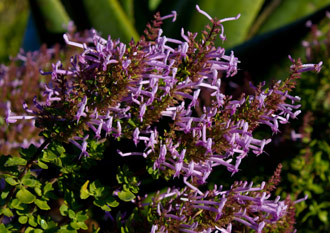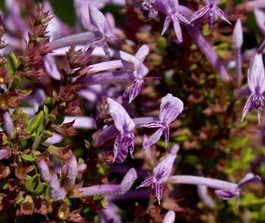Thorncroftia succulenta
Thorncroftia succulenta ( R.A. Dyer & E.A. Bruce) Codd
Family: Lamiaceae
Common names: rock sage (Eng.) ; klipsalie (Afr.)
Introduction
Thorncroftia succulenta is a versatile and attractive semi-succulent shrub which makes an excellent and showy garden subject, well suited for hot dry and sunny gardens.

Description
Description
Thorncroftia succulenta is technically a succulent due to its semi-succulent stems and leaves, however, it behaves and grows much like a herbaceous shrub forming a well-branched bush up to 1 m and occasionally 1.5 m high. It forms numerous fleshy stems which arise from a woody rootstock, each covered in very fine velvety hairs when young. These stems eventually become a grey-brown and semi-woody as they mature. The opposite grey-green succulent leaves are obovate in shape with rounded teeth in the upper two-thirds, are covered with short hairs and attached to the stem by short stalks.

The pinky-mauve flowers are long and tubular with petals flaring at the mouth with the lower most bearing dark purple spots. The flowers are carried in dense terminal spikes forming impressive displays of colour from February to June. The small round dark brown or black seeds are nested in the base of the calyx, visible once the corolla tube has fallen off. They take a couple of months to ripen. Under warm and sunny conditions this species will grow fairly quickly becoming a well-shaped shrub in 1 year, and however they will last many years in the open ground.
Conservation Status
Status
This species is not currently known to be threatened or rare in any way.
Distribution and habitat
Distribution description
Thorncroftia succulenta occurs in the Limpopo and Mpumalanga provinces of South Africa usually associated with rocky outcrops often growing in humus-filled crevices. It is very well suited to general garden situations in full sun and ideal for rockeries.
Derivation of name and historical aspects
History
The genus Thorncroftia is named in honour of George Thorncroft (1857 - 1934) who collected botanically extensively in the Barberton area. The specific name succulenta refers to its succulent/fleshy nature. There are a total of 5 species in the genus Thorncroftia and all are endemic to South Africa. They were originally thought to be members of the closely-related genus Plectranthus.
Ecology
Ecology
Because of its succulent nature, this species is well-adapted to growing in shallow soils and rock crevices which often experience periods of drought in between rain spells. This adaptation allows it to out compete other herbaceous or woody plants that don't have the same life-sustaining water reserves.
Uses
Use
There are no known medicinal or cultural uses for this plant.
Growing Thorncroftia succulenta
Grow
This is possibly one of the easiest and hardiest of all herbaceous South African garden plants to grow. It will survive under a vast spectrum of soil types and climatic conditions and is even frost hardy. It prefers sunny positions, particularly afternoon sun and thrives in subtropical temperatures which can be simulated by planting it amongst rocks or boulders which retain heat. It prefers wet summers and dry winters but will tolerate water during winter and will survive summer with minimal water. It does not require rich composted soils but will thrive if compost is provided, which is also true of fertilizers.
Due to their fragrant sage leaves, they naturally have very few pests and seem to be resilient to fungal and other pathogens. In their natural habitat is a weevil which attacks all species of Thorncroftia called Apion rectangulum which causes thickened swellings in the stems. This is seldom seen in cultivation, however.
Propagation is easiest by cuttings which can be soft or hardwood and rooted without the need of rooting hormone at any time of the year, but spring and summer is best. The rooting medium should preferably be sand but they should strike in any soil without the need for shade or a plastic covering. One could probably also root them in water.
Seed should be collected during July or August and kept until September/October (spring) for sowing (in the southern hemisphere). They should be mixed with fine dry sand and sprinkled evenly over a suitable germination medium in a tray. Watering with a fungicide is advisable but not essential. Depending on the ambient temperatures they should germinate within 2 - 4 weeks. Seedlings grow vigorously and will quickly outgrow cuttings of the same age.
References
- Germishuizen, G. & Fabian, A. 1997. Wild flowers of northern South Africa. Fernwood Press, Vlaeberg, Cape Town.
- Codd, L.E.W. 1985. Lamiaceae. Flora of southern Africa. Volume 28, Part 4. Botanical Research Institute, Pretoria.
- Leistner, O.A. (ed.). 2000. Seed plants of southern Africa: families and genera. Strelitzia 10. National Botanical Institute, Pretoria.
Credits
Adam Harrower
Kirstenbosch National Botanical Garden
July 2012
Plant Attributes:
Plant Type: Perennial, Shrub, Succulent
SA Distribution: Limpopo, Mpumalanga
Soil type:
Flowering season: Late Summer, Autumn
PH:
Flower colour: Mauve/Lilac
Aspect: Full Sun
Gardening skill: Easy
Special Features:
Horticultural zones











Rate this article
Article well written and informative
Rate this plant
Is this an interesting plant?
Login to add your Comment
Back to topNot registered yet? Click here to register.